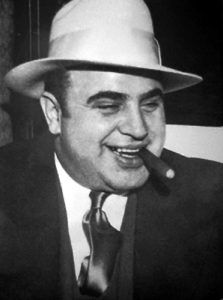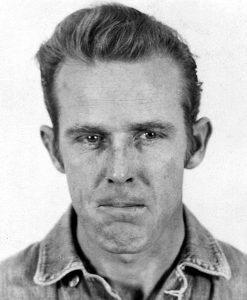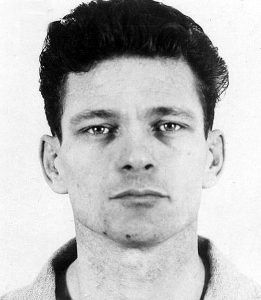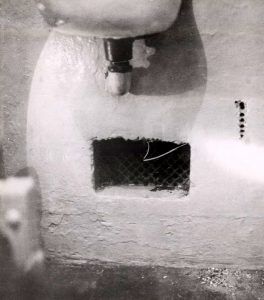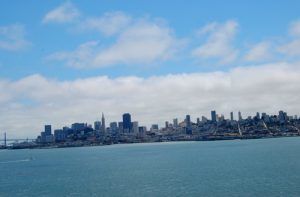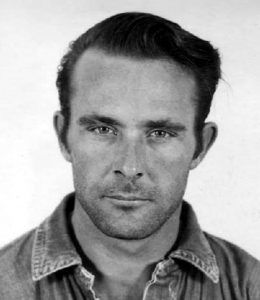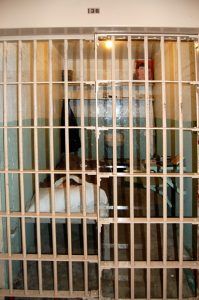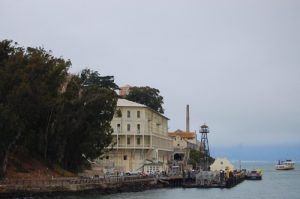In its heyday, Alcatraz, California, was the ultimate maximum security prison.
Located on a lonely island in the middle of San Francisco Bay, Alcatraz, also known as “The Rock,” has held captives since the Civil War. In 1934, the high point of a major war on crime was that Alcatraz was re-fortified into the world’s most secure prison. Its eventual inmates included dangerous public enemies like Al Capone, criminals with a history of escapes, and occasional odd characters like the infamous “Birdman of Alcatraz.”
In the 1930s, Alcatraz was already a forbidding place, surrounded by the cold, rough waters of the Pacific Ocean. Its redesign included tougher iron bars, a series of strategically positioned guard towers, and strict rules, including a dozen checks a day of the prisoners. Escape seemed near impossible.
Despite the odds, from 1934 until the prison was closed in 1963, 36 men attempted 14 separate escapes. Nearly all were caught or didn’t survive.
However, the fate of three inmates remains a mystery to this day.
On June 12, 1962, the routine early morning bed check was anything but. Three convicts were not in their cells: John Anglin, his brother Clarence Anglin, and Frank Morris. In their beds were cleverly built dummy heads made of plaster, flesh-tone paint, and real human hair that apparently fooled the night guards. The prison went into lockdown, and an intensive search began.
John and Clarence Anglin were born into a family of 13 children in Donalsonville, Georgia. Their parents, George Robert and Rachael Van Miller Anglin, were seasonal farmworkers. In the early 1940s, the family moved to Ruskin, Florida, 20 miles south of Tampa, where the truck farms and tomato fields provided a more reliable income source. Still, they would move north as far as Michigan every June to pick cherries. Clarence and John were reportedly inseparable as youngsters.
The brothers were arrested in 1958 for robbing a bank in Columbia, Alabama, given 15-20 year sentences, and sent to the Atlanta Penitentiary, where they first met Frank Morris and Allen West. Later, they were transferred first to the Florida State Prison and then to the Leavenworth Federal Penitentiary in Kansas. When the pair tried to escape from Leavenworth, they were sent to Alcatraz, with John arriving on October 21, 1960, and Clarence arriving on January 10, 1961. Within a year, they began to plan an elaborate escape attempt with Frank Morris and Allen West.
Frank Lee Morris (1926-??) was born in Washington, D.C., and was orphaned at age 11, spending most of his formative years in foster homes. He was convicted of his first crime at the age of 13 and, by his late teens, had been arrested for crimes ranging from narcotics possession to armed robbery. Morris was exceptionally intelligent, ranking in the top two percent of the general population measured by IQ testing. He served time in Florida and Georgia, then escaped from the Louisiana State Penitentiary while serving ten years for bank robbery. He was recaptured a year later while committing a burglary and sent to Alcatraz in 1960. He, along with John and Clarence Anglin, escaped in June 1962 and were never seen again.
Also involved was a fourth conspirator who didn’t make it out that day. His name was Allen Clayton West. After being convicted of car theft in 1955, he was sent to the Atlanta Penitentiary and then to the Florida State Prison. After an unsuccessful escape attempt in Florida, he was transferred to Alcatraz in 1957. On the eventful day of the escape, West could not finish removing the ventilator grill in his cell in time and was left behind.
Once the escape was realized, the FBI was notified immediately and asked to help. The San Francisco office began to check nationwide for any records on the missing prisoners and their previous escape attempts. The agents also interviewed the men’s relatives, compiled their identification records, and asked boat operators in the Bay to be on the lookout for debris. Within two days, a packet of letters sealed in rubber and related to the men was recovered. Later, some paddle-like pieces of wood and bits of rubber inner tube were found in the water. A homemade life vest was also discovered washed up on Cronkhite Beach, but extensive searches did not turn up any other items in the area.
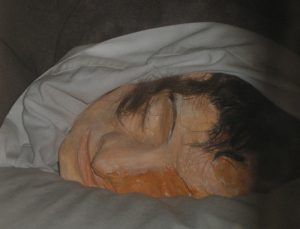
One of the heads used in the escape of the Anglin brothers and Frank Morris is still on display in a cell, Kathy Alexander.
As the days passed, the FBI, the Coast Guard, the Bureau of Prison authorities, and others began to find more evidence and piece together the ingenious escape plan. The investigators were aided by Allen West, who didn’t leave his cell in time.
The agents discovered that the group had begun laying plans the previous December when one of them came across some old saw blades. Using crude tools — including a homemade drill made from the motor of a broken vacuum cleaner — the conspirators each loosened the air vents at the back of their cells by painstakingly drilling closely spaced holes around the cover so the entire section of the wall could be removed. Once through, they hid the holes with whatever they could — a suitcase, a piece of cardboard, etc.
Behind the cells was a common, unguarded utility corridor. They went down this corridor and climbed to the roof of their cell block inside the building, where they set up a secret workshop. There, taking turns keeping watch for the guards on the evening before the last count, they used various stolen and donated materials to build and hide what they needed to escape. The prisoners used more than 50 raincoats they stole to build makeshift life preservers and a 6×14 foot rubber raft, the seams of which were carefully stitched together and “vulcanized” by the hot steam pipes in the prison. They also built wooden paddles and converted a musical instrument into a tool to inflate the raft.
At the same time, they were looking for a way out of the building. The ceiling was a good 30 feet high, but they climbed up using a network of pipes and eventually pried open the ventilator at the top of the shaft. They kept it in place temporarily by fashioning a fake bolt made out of soap.
On the evening of June 11, they were ready to go. Allen West, though, did not have his ventilator grill completely removed and was left behind. The three others got into the corridor, gathered their gear, climbed up and out through the ventilator, and got onto the prison roof. They then shimmied down the bakery smokestack at the rear of the cell house, climbed over the fence, snuck to the island’s northeast shore, and launched their raft.
What happened next remains a mystery. Did they make it across the Bay, get to Angel Island, and then cross Raccoon Strait into Marin County as planned? Or did they drown when the wind and waves got the better of them?
Many people have gone to great lengths to prove that the men could have survived, but the question remains — did they? At the time, the FBI’s investigation concluded that they couldn’t have lived for the following reasons.
Crossing the Bay – Though people have, in fact, swam the more than the mile-long distance from Alcatraz to Angel Island, the night that the three men escaped, there were strong currents in the frigidly cold water, making the odds very low against their survival.
Change of Plans – According to prison informant Allen West, the escapees’ original plan was to steal clothes and a car once they had arrived on land. However, no thefts like this were reported despite the case’s high-profile nature.
Family Ties – It would seem that the fugitives would have needed help, but the FBI could never find a connection. Furthermore, the prisoners’ families appeared unlikely to have the financial means to provide any real support.
Missing For Years – For the 17 years the FBI worked on the case, no credible evidence emerged to suggest the men were still alive, either in the United States or in foreign countries.
The FBI officially closed their case on December 31, 1979, and turned over responsibility to the U.S. Marshals Service. The mystery continues to this day.
Aftermath:
In 1993, a former Alcatraz inmate named Thomas Kent told the television program America’s Most Wanted that he had helped plan the escape and provided “significant new leads” to investigators. He said that Clarence Anglin’s girlfriend had agreed to meet the men on the mainland and drive them to Mexico. He declined to participate in the actual attempt because he could not swim. Officials were skeptical of Kent’s account because he had been paid $2,000 for the interview.
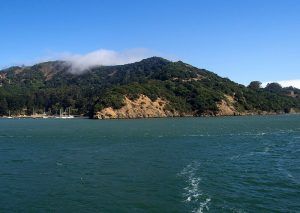
Angel Island, California, courtesy Wikipedia
A 2003 MythBusters episode on the Discovery Channel tested the feasibility of an escape from the island aboard a raft constructed with the same materials and tools available to the inmates. It determined that it was “plausible.” A 2011 program on the National Geographic Channel asserted that footprints were found on the Angel Island beach where the raft wreckage was recovered and that, contrary to the official FBI report, a car had been stolen nearby on the night of the escape.
In 2011, an 89-year-old man named Bud Morris, who said he was a cousin of Frank Morris, claimed that on “eight or nine” occasions before the escape, he delivered envelopes of money to Alcatraz guards, presumably as bribes. He further claimed to have met his cousin face-to-face in a San Diego park shortly after the escape. His daughter, who was “eight or nine” years old at the time, said she was present at the meeting with “Dad’s friend, Frank,” but “had no idea [about the escape].”
In 2012, the 50th anniversary of the escape attempt, the Anglins’ two sisters and two of their nephews made public their belief that Clarence and John — who would be well into their 80s — were still alive. Marie Anglin Winder claimed that in 1962, she received a phone call from San Francisco after the escape; the caller said, “This is John Anglin.” The family also produced a Christmas card, purportedly received in the family mailbox in 1962, saying, “To Mother, from John. Merry Christmas.” Michael Dyke, a Deputy U.S. Marshal, conceded that there is a “possibility that they survived” — but noted that a Norwegian freighter reported seeing a body floating in the ocean 15 miles from the Golden Gate Bridge about one month after the escape. “He wore prison clothes — a navy pea coat and a light pair of trousers — similar to what [Alcatraz] prisoners wore. There were no other missing people during that period.”
In 2014, researchers at Delft University, using a computer model, concluded that if the men set off approximately at midnight, when the currents might have worked in their favor, they could have made landfall, but if they left during the hours before or after, the currents would have been too strong to overcome and they very likely died.
A 2015 History Channel documentary presented further circumstantial evidence gathered by the Anglin brothers’ family over the years. Christmas cards containing the Anglins’ handwriting, allegedly received by family members for three years after the escape, were displayed. While the handwriting was verified as the Anglins’, none contained a postmarked stamp, so experts could not determine when they were delivered. The family cited a story from family friend Fred Brizzi, who grew up with the brothers and claimed to have recognized them in Rio de Janeiro, Brazil, in 1975. They produced photographs taken, they said, by Brizzi (who died in 1993), including one showing two men resembling John and Clarence Anglin and the farm near Rio where they were purportedly living. Forensic experts hired by the History Channel confirmed that the photos were taken in 1975 and asserted that the two men were “more than likely” the Anglins. Other evidence included the deathbed confession of another of the Anglins’ 11 siblings, Robert, who told family members in 2010 that he had been in contact with John and Clarence from 1963 until approximately 1987. The film also presented an alternate escape theory involving the use of an electrical cord — which was reported missing from the prison’s dock on the night of the escape — as a tow line attached to a passenger ferry that departed the island shortly after midnight.
Art Roderick, a retired Deputy U.S. Marshal working with the Anglin family, called Brizzi’s photograph of the two men “absolutely the best actionable lead we’ve had” — but added, “it could still all be a nice story which isn’t true”; or the photograph could be a misdirection, aimed at steering the investigation away from the Anglins’ actual whereabouts. Michael Dyke, the Deputy Marshal assigned to the case, said Brizzi was “a drug smuggler and a conman” and was suspicious of his account. An expert working for the U.S. Marshals Service reported that measurements of the photo subjects’ physical features, compared to those of the Anglin brothers, indicated that they were not the men in the photo. However, the age and condition of the photo and the fact that both men were wearing sunglasses hindered efforts to make a definitive determination.
Surviving family members, who said they had heard nothing since Robert lost contact with the brothers in 1987, announced plans to travel to Brazil to conduct a personal search. Still, Roderick cautioned that Brazilian authorities could arrest them because the Alcatraz escape remains an open Interpol case.[26] According to information obtained by a British newspaper, the FBI was aware of rumors that the Anglins were in Brazil as early as 1965. Agents dispatched to Rio at that time reportedly found no credible evidence that the fugitives were there.
Allen West, who cooperated fully with the escape investigation and was not charged for his role in the attempt. When Alcatraz was deactivated in 1963, West was transferred to McNeil Island, Washington, and later back to Atlanta Penitentiary. After serving his sentence, followed by two additional sentences in Georgia and Florida, he was released in 1967, only to be arrested again in Florida the following year on charges of grand larceny. At Florida State Prison, he fatally stabbed another prisoner in October 1972. He was serving multiple sentences, including life imprisonment on the murder conviction, when he died of acute peritonitis on December 21, 1978, at the age of 49.
Also See:
The Long History of Alcatraz Island
Sources:
FBI History
Wikipedia
David Hunter, Historian of the Columbia Historical Society, Columbia, Alabama


